An Investigation of Pensioner Employment
The report explores the drivers behind the consistent increase in pensioner employment over the past decade, including throughout the last recession. It discusses the employment characteristics and socio-economic conditions of pensioners who continue to w
Employment Characteristics Of Working Pensioners
Working pensioners are more likely to be self-employed than other age groups
Working pensioners are in their majority employees but, as indicated in the following chart, working people aged 65+ are more likely than any other age group to be self-employed. Working pensioners are also more likely than any other age group to be unpaid family workers, for example working in family restaurant business.
Figure 11: Employment by age group and employment status, Jan-Dec 2015
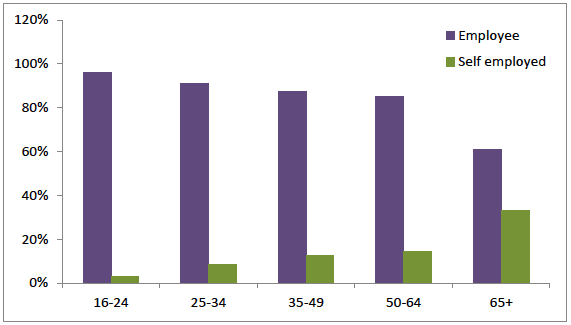
Source: Scottish Government analysis based on Annual Population Survey, Jan-Dec 2015, ONS
Note: Employment level includes Government sponsored trainees and unpaid family workers
The following chart shows the growth in numbers of employed and self-employed men and women in Scotland over the past decade. Pensioner self-employment has been growing strongly over the past decade, with an apparent surge in self-employed women.
However, between 2014 and 2015 there was a fall in the number of self-employed male pensioners and a rise in the number of male employees. As the levels of pensioner employment are fairly similar in the past two years, this suggests that some working pensioners have shifted from self-employment into employment.
Nonetheless, the increase in pensioner self‑employment over the past decade, despite the small decline last year, might signal older workers looking for more flexible working patterns.
Figure 12: Growth in numbers of 65+ employed and self-employed workers in Scotland, 2004=100
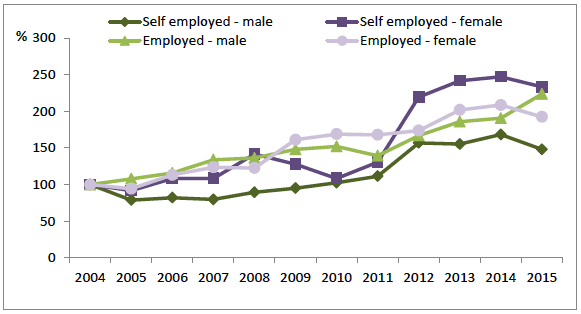
Source: Scottish Government analysis based on Annual Population Survey, Jan-Dec 2015, ONS
Although the number of male pensioners working part-time has increased considerably, many more men than women work full-time
Number of pensioners working part-time rose considerably over the past decade and numbers of part-time workers between the genders have been very similar since 2009.
Figure 13: Numbers of part-time working pensioners in Scotland
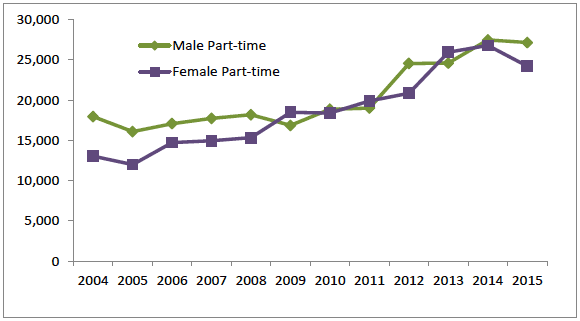
Source: Scottish Government analysis based on Annual Population Survey, Jan-Dec 2015, ONS
However, despite the fall in levels of male pensioners working full-time over the last year, there were considerably more male full-time pensioners in employment (22,000 in 2015) than female full-time pensioners (6,400 in 2015).
Figure 14: Numbers of full-time working pensioners in Scotland
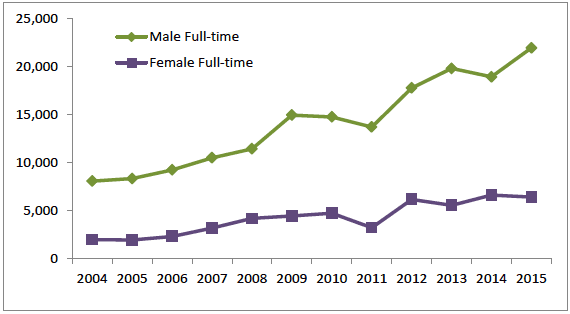
Source: Scottish Government analysis based on Annual Population Survey, Jan-Dec 2015, ONS
Analysis of the rates of increase in full-time and part-time employment shows that female full-time work had the highest growth rate over the past decade. However, over the last year male full-time work has fallen considerably whilst male part-time work had a steady increase, especially since 2011.
Figure 15: Growth in part-time and full-time workers in Scotland, 2004-2015, 2004=100
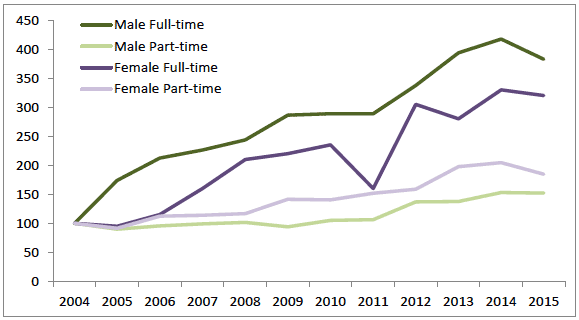
Source: Scottish Government analysis based on Annual Population Survey, Jan-Dec 2015, ONS
Pensioners work less hours than younger age groups
As would be expected, mean weekly hours are lower for the 65+ age group than younger age groups. Mean weekly hours worked across all types of employment are lower for women than men in the 65+ age group, consistent with all other age groups.
Figure 16: Average (mean) weekly hours worked in main and second jobs by age and gender, Scotland, 2015
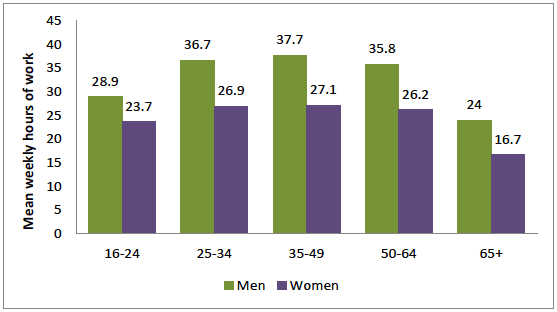
Source: Scottish Government analysis based on Annual Population Survey, Jan-Dec 2015, ONS
The following chart shows the total hours worked by age group - in particular that whilst employment has risen considerably, the total hours worked by the 65+ age group still represents a very small proportion of overall hours worked, at around 2%.
Figure 17: Total weekly hours worked in main and second jobs by age and gender, Scotland, 2015
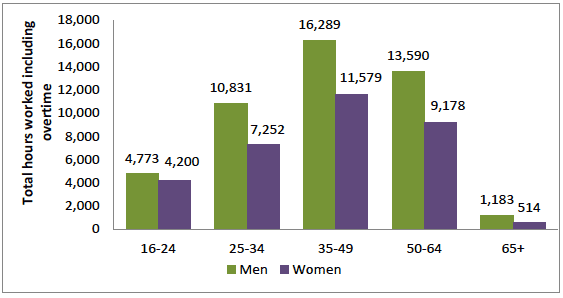
Source: Scottish Government analysis based on Annual Population Survey, Jan-Dec 2015, ONS
Self-employed pensioners earn less than employee pensioners
Data on median gross weekly earnings for self-employment in Scotland suggest that self-employed working pensioners are earning less than pensioner employees. The following chart compares the different median gross weekly earnings for male and female pensioners.
Figure 18: Median gross weekly earnings by gender and employment status in Scotland, over 65s, 2013/14
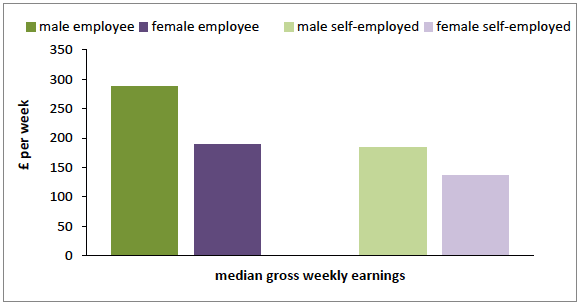
Source: Scottish Government analysis based on data selection from Households Below Average Income, £ per week 2013/14 prices
The gender pay gap has been widening for older age groups
Analytical work on the gender pay gap has shown that women over 60 in the UK are earning less than men both in part-time and full-time occupations. Whilst the gender pay gap is smaller for all younger age cohorts (people born after 1975), it has been widening for the older age groups (people born before 1975). A possible reason for this could be the increase in the following occupational areas: elementary and caring, leisure and other services. This work is disproportionately done by women, as discussed in the following sections of this chapter.
Figure 19: Gender pay gap for median gross hourly earnings (excluding overtime) by age group, UK, April 2015
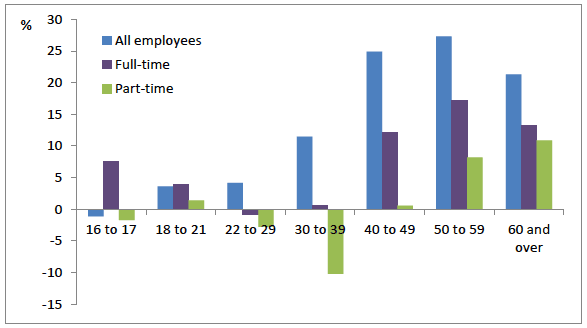
Source: Annual Survey of Hours and Earnings ( ASHE) - Office for National Statistics
Working pensioners are more likely to be over-employed than under-employed
There are higher numbers of pensioners who would like to work fewer hours (over-employment) than there are numbers working part-time who want to work more hours (under-employed). The number of overemployed people aged 65+ has grown considerably over the past decade as shown in Figure 20.
Based on distributional analysis of sources of income set out later in this report, it is likely that over-employment amongst pensioners relates more to higher value work than low pay work. Given the high proportion of self-employment in the 65+ age group, it is also likely that many over-employed pensioners are also self-employed.
The increase on pensioner over-employment may be expected, given the increases in overall employment levels, but suggests that some pensioners may be working full-time to avoid having to downgrade skill level and, most likely, therefore see a decrease in wage rates (part-time work is generally lower skilled and therefore lower paid).
This may suggest that increases in flexible working could result in a reduction of some pensioners hours, whilst others may choose to work at a higher skill level who otherwise may have retired.
Figure 20: Numbers of over- and under-employed people aged 65+, 2004 to 2015
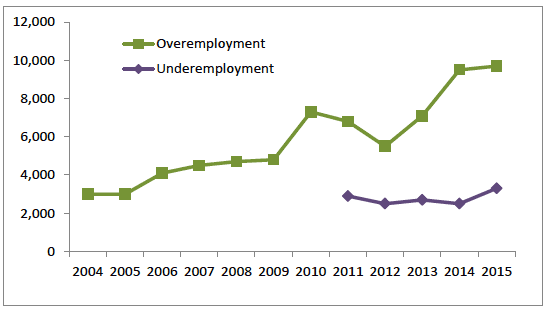
Source: Scottish Government analysis based on Annual Population Survey, Jan-Dec 2015, ONS
Pensioner employment has grown strongly across all occupation groups but female pensioners are doing more low skilled work
Trends in employment of older workers are looked at by broad occupation group. Availability of data at a more detailed level of occupational classification is not consistently available across occupations, and therefore is not presented.
Unsurprisingly, given the increase in overall employment rates, all broad occupations groups show marked increases in employment levels between 2004 and 2015 as illustrated in Figure 21.
Figure 21: Employment of pensioners by broad occupational group, 2004 and 2015, Scotland
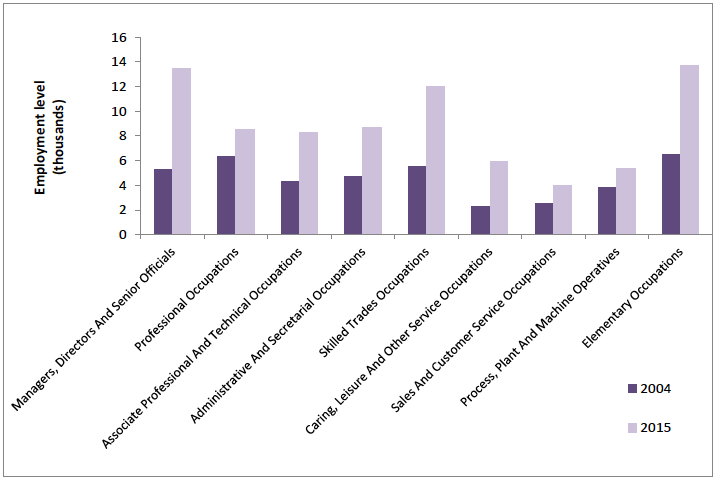
Source: Scottish Government analysis based on Scottish Government analysis based on Annual Population Survey, Jan-Dec 2015, ONS
However, as Figure 22 shows, the largest growth in numbers between 2004 and 2015 has occurred in broad occupation groups, which are likely to be medium or higher skilled work such as skilled trades, professional and managerial occupations. It is worth highlighting that elementary occupations have seen the second largest increase in numbers overall (7,200), while caring, leisure and other services occupations have the highest proportional increase (161%). The lowest growth in numbers was in lower skilled occupations such as sales and customer services and process, plant and machinery operatives occupations.
Figure 22: Increase in employment of pensioners by broad occupational group between 2004-2015, Scotland
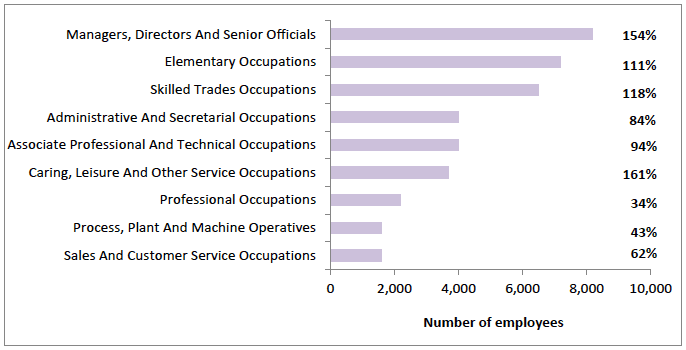
Source: Scottish Government analysis based on Annual Population Survey, Jan-Dec 2015, ONS
The following chart shows that female pensioners work considerably more in medium-low and low skilled occupations than male pensioners. Therefore, the increases in elementary and caring, leisure and other service occupations can be mainly attributed to female pensioner employment. This evidence reflects with the widening gender pay gap in older age groups, as discussed earlier in this section.
Figure 23: Proportion of employment at each skill level for male and female working pensioners, Scotland 2015
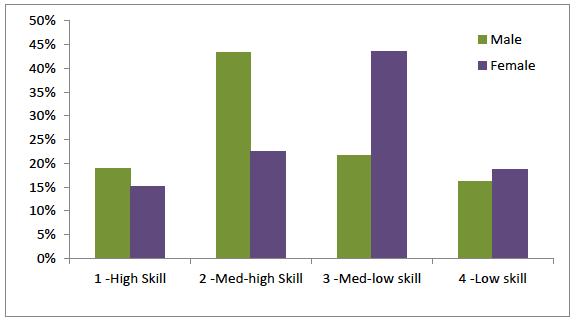
Source: Scottish Government analysis based on Annual Population Survey, Jan-Dec 2015, ONS
Looking at the distribution of pensioner employment at each skill level over time, as illustrated in Figure 24, there is some variability across all skill categories over time, but since 2006 there seems to be reasonably consistent upwards trend in those working in medium-high and low skill occupations, and a relatively decreasing trend for those in the medium-low and high skill occupation.
Figure 24: Distribution of pensioners in employment at each skill level between 2004 and 2015
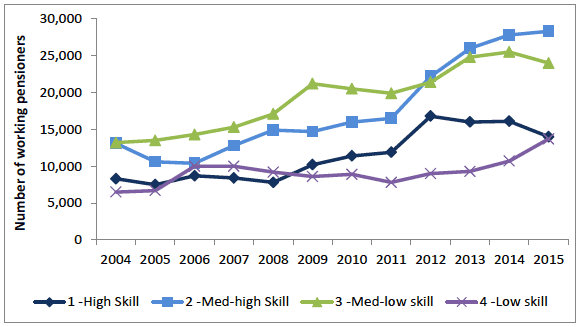
Source: Annual Population Survey, Jan-Dec 2015, ONS
However, Figure 25 shows that those over 65 tend to work more in low skilled jobs and less in high skilled positions than any other age group except 16-24s. This suggests, consistent with anecdotal evidence, that people who work beyond 65 tend to downgrade their skill level. This could also be linked with increases in part-time working.
Figure 25: Proportion of employment at each skill level for each age group, Scotland 2015
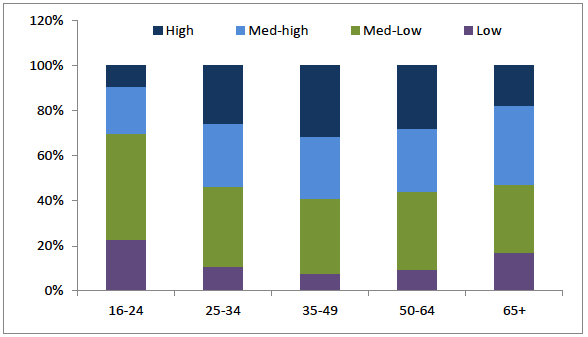
Source: Scottish Government analysis based on Annual Population Survey, Jan-Dec 2015, ONS
Contact
There is a problem
Thanks for your feedback